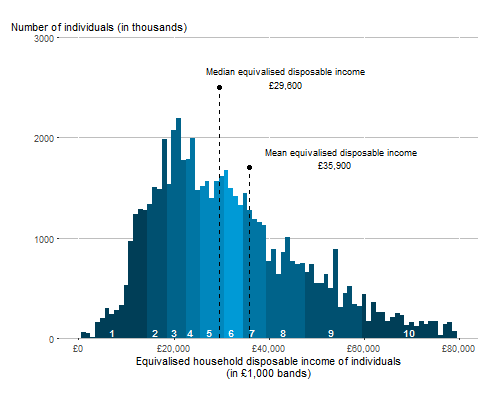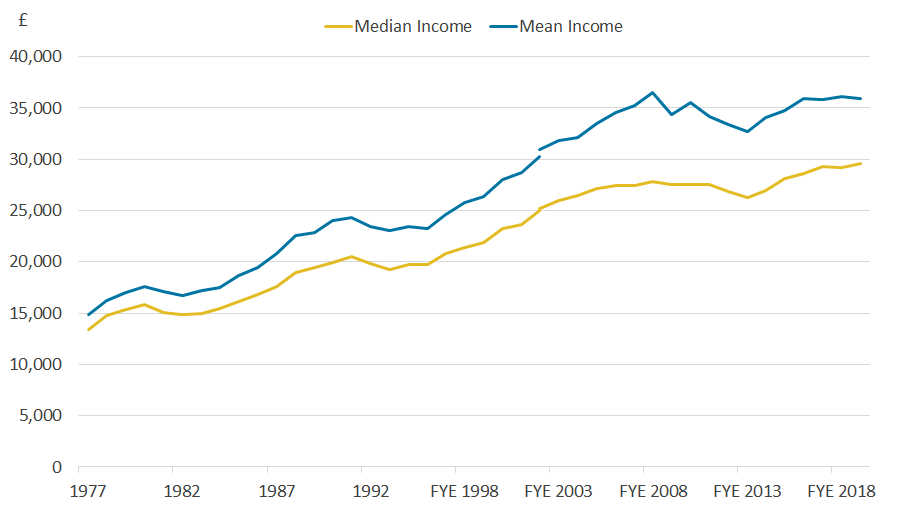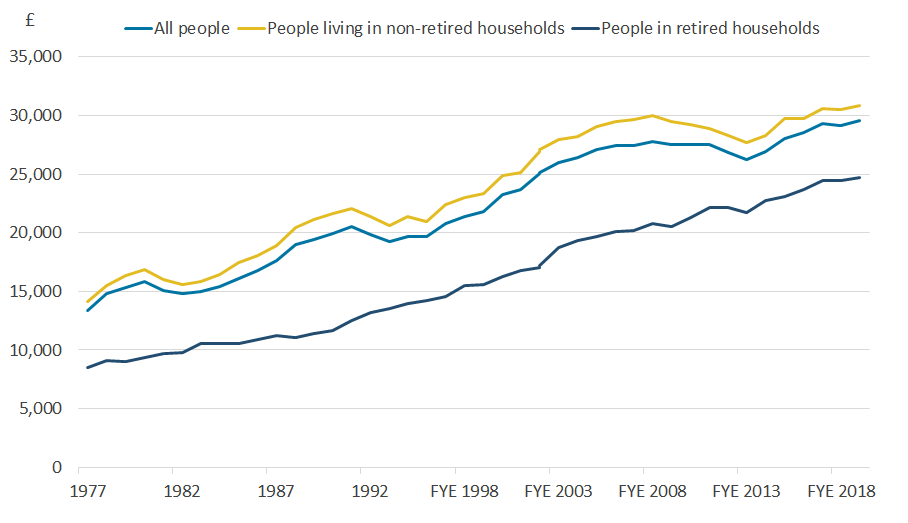1. Other pages in this release
Commentary on household income inequality in financial year ending 2019 is reported in a separate bulletin:
Nôl i'r tabl cynnwys2. Main points
Median household disposable income in the UK was £29,600 in financial year ending (FYE) 2019, based on estimates from the Office for National Statistics's (ONS's) Living Costs and Food Survey.
Growth in median income stalled between FYE 2017 and FYE 2019 growing on average by 0.4% per year, compared with 3.0% per year between FYE 2013 and FYE 2017.
Median income for the poorest fifth of people fell by 4.3% per year over the two years up to FYE 2019, following average annual growth of 3.4% over the four years leading up to FYE 2017.
Median income of the richest fifth also fell between FYE 2017 and FYE 2019 (0.4% per year), meaning that despite average annual growth of 1.7% per year between FYE 2013 and FYE 2017, average income remains lower than levels reached prior to the economic downturn in FYE 2008.
Median income for people living in retired households and non-retired households over the two years leading up to FYE 2019 increased by 0.5% and 0.3% per year respectively; this compares with the period between FYE 2013 and FYE 2017, where average annual growth for these groups was 3.1% and 2.7% respectively.
3. Analysis of average income
Figure 1: Median income was £29,600 in the FYE 2019
Distribution of UK household disposable income, financial year ending 2019

Source: Office for National Statistics – Living Costs and Food Survey
Download this image Figure 1: Median income was £29,600 in the FYE 2019
.png (6.1 kB) .xlsx (20.4 kB)This bulletin looks at two measures of people's household disposable income: median and mean. Both measures are equivalised, meaning that they take into account that households with more people will need a higher income to achieve the same standard of living as households with fewer members. They are also measured before accounting for housing costs.
The distribution of equivalised disposable income in the UK is skewed towards lower income people; mean income (£35,900) is £6,300 larger than median income (£29,600).
Figure 2: Median income grew during financial year ending 2019
Median and mean real equivalised household disposable income of individuals, UK, 1977 to financial year ending 2019

Source: Office for National Statistics – Living Costs and Food Survey
Notes:
- Incomes are adjusted for inflation using the consumer prices index including owner-occupiers’ housing costs (CPIH).
- Estimates of income from FYE 2002 onwards have been adjusted for the under coverage of top earners.
- FYE 1995 represents the financial year ending 1995, and similarly through to FYE 2019, which represents the financial year ending 2019. Estimates prior to FYE 1995 are measured on a calendar year basis.
- For median income, individuals are ranked by their equivalised household disposable incomes, using the modified OECD scale.
Download this image Figure 2: Median income grew during financial year ending 2019
.png (25.0 kB) .xlsx (19.9 kB)Growth in median income has slowed over recent years, to an average of 0.4% per year between financial year (April to March) ending (FYE) 2017 and FYE 2019. This contrasts with the four years leading up to FYE 2017, where median income increased by 3.0% per year between FYE 2013 and FYE 2017.
As explored in more detail in Average household income, UK: Financial year ending 2019 (provisional), these more modest changes in median income coincide with a period of growth in real earnings, coupled with an increase in the number of people in employment. However, improving labour market conditions on household income were moderated by a continued freeze on certain working-age benefits, such as Income Support and Child Benefit, which remained at FYE 2016 cash values.
Figure 3: Average income of the poorest fifth of people fell by 4.3% per year on average between FYE 2017 and FYE 2019
Median equivalised household disposable income of individuals by quintile group, FYE 2008 to FYE 2019 (Index FYE 2008 = 100)
Source: Office for National Statistics – Living Costs and Food Survey
Notes:
- Individuals are ranked by their equivalised household disposable incomes, using the modified OECD scale.
- Incomes are adjusted for inflation using the consumer prices index including owner-occupiers’ housing costs (CPIH).
- FYE 2008 represents the financial year ending 2008, and similarly through to FYE 2019, which represents the financial year ending 2019.
Download this chart Figure 3: Average income of the poorest fifth of people fell by 4.3% per year on average between FYE 2017 and FYE 2019
Image .csv .xlsContrasting growth in median income during the four years leading up to FYE 2017, compared with the two years after, is reflected more widely across the distribution. In particular, the median income of the poorest fifth of people fell by 4.3% per year between FYE 2017 and FYE 2019, compared with growth of 3.4% per year in the four years after FYE 2013. The recent downturn in income for the poorest fifth of people in part reflects that a larger proportion of their household income is composed of cash-benefits, where many, as explained earlier, are frozen at their FYE 2016 values.
Over the two years since FYE 2017, the median income of the richest fifth of people fell by 0.4% per year. This means that, despite average annual growth of 1.7% per year between FYE 2013 and FYE 2017, the median income of the richest fifth of people remains below levels prior to the economic downturn in FYE 2008.
Figure 4: Median income of people living in retired households increased in FYE 2019
Median equivalised disposable household income for individuals living in retired, and non-retired households, and all individuals 1977 to FYE 2019

Source: Office for National Statistics – Living Costs and Food Survey
Notes:
- Incomes are adjusted for inflation using the consumer prices index including owner-occupiers’ housing costs (CPIH).
- Individuals are ranked by their equivalised household disposable incomes, using the modified OECD scale.
- Estimates of income from FYE 2002 have been adjusted for the under coverage of top earners.
- FYE 1995 represents the financial year ending 1995, and similarly through to FYE 2019, which represents the financial year ending 2019. Estimates prior to FYE 1995 are measured on a calendar year basis.
Download this image Figure 4: Median income of people living in retired households increased in FYE 2019
.png (31.0 kB) .xlsx (20.3 kB)Looking separately at retired and non-retired people, Figure 4 highlights similar trends to those observed for the overall population. Median income for people living in retired households and non-retired households over the two years leading up to FYE 2019 increased by an average of 0.5% and 0.3% per year respectively. This compares with the period between FYE 2013 and FYE 2017, where average annual growth for these groups was 3.1% and 2.7% respectively.
More analysis on the longer-term picture of retired and non-retired income is contained within the article What has happened to the income of retired households in the UK over the past 40 years?
Figure 5: New top income adjustment tends to increase levels of median and mean income
Median and mean income, adjusted and unadjusted, financial year ending 2002 to financial year ending 2019, UK
Source: Office for National Statistics – Living Costs and Food Survey
Notes:
- For median income, individuals are ranked by their equivalised household disposable incomes, using the modified OECD scale.
- Incomes are adjusted for inflation using the consumer prices index including owner-occupiers’ housing costs (CPIH).
- FYE 2002 represents the financial year ending 2002, and similarly through to FYE 2019, which represents the financial year ending 2019.
Download this chart Figure 5: New top income adjustment tends to increase levels of median and mean income
Image .csv .xlsHeadline estimates of income for FYE 2019 published in this bulletin are the first to be adjusted for the under-coverage of the richest earners. While more details of the methodology are presented in Top income adjustment in effects of taxes and benefits data: methodology, this adjustment increases both the number and incomes of the very richest people, using information from HM Revenue and Customs' Survey of Personal Incomes (SPI), an administrative sample of UK tax records.
Comparing adjusted and unadjusted estimates of mean and median income, Figure 5 highlights the adjustment increases the mean, and to a much lesser extent the median. Between FYE 2002 and FYE 2019 - the years in which we have adjusted survey data because of the availability of SPI data - mean income increases by £1,600 (4.9%) because of the introduction of the adjustment. As a consequence of the adjustment, mean income is now estimated to be lower than levels recording in FYE 2008, just prior to the economic downturn.
Over the period FYE 2002 to FYE 2019, median income increases by an average of £200 (0.8%) because of the introduction of the top income adjustment.
Nôl i'r tabl cynnwys4. Average household income data
The effects of taxes and benefits on household income, disposable income estimate: 2019
Dataset | Released 5 March 2020
Average UK household incomes taxes and benefits by household type, tenure status, household characteristics and long-term trends in income inequality.
5. Glossary
Disposable income
Disposable income is arguably the most widely used household income measure. Disposable income is the amount of money that households have available for spending and saving after direct taxes (such as Income Tax, National Insurance and Council Tax) have been accounted for. It includes earnings from employment, private pensions and investments as well as cash benefits provided by the state.
Equivalisation
Comparisons across different types of individuals and households (such as retired and non-retired, or rich and poor) or over time is done after income has been equivalised. Equivalisation is the process of accounting for the fact that households with many members are likely to need a higher income to achieve the same standard of living as households with fewer members. Equivalisation considers the number of people living in the household and their ages, acknowledging that while a household with two people in it will need more money to sustain the same living standards as one with a single person, the two-person household is unlikely to need double the income.
This analysis uses the modified Organisation for Economic Co-operation and Development (OECD) equivalisation scale (PDF, 165KB).
Mean and median income
The mean measure of income divides the total income of individuals by the number of individuals. A limitation of using the mean is that it can be influenced by just a few individuals with very high incomes and therefore does not necessarily reflect the standard of living of the "typical" person. However, when considering changes in income and direct taxes by income decile or types of households, the mean allows for these changes to be analysed in an additive way.
Many researchers argue that growth in median household incomes provides a better measure of how people's well-being has changed over time. The median household income is the income of what would be the middle person, if all individuals in the UK were sorted from poorest to richest. Median income provides a good indication of the standard of living of the "typical" individual in terms of income.
Nôl i'r tabl cynnwys6. Measuring the data
This release provides headline estimates of average disposable income. These data are from the Living Costs and Food Survey (LCF), a voluntary sample survey of around 5,000 private households in the UK. These statistics are assessed fully compliant with the Code of Practice for Statistics and are therefore designated as National Statistics.
More quality and methodology information on strengths, limitations, appropriate uses, and how the data were created is available in the Effects of taxes and benefits on household income QMI.
Retired and non-retired households
This bulletin presents analysis examining the incomes of people who live in retired households. A retired household is one where more than 50% of its income is sourced from retired people. A retired person requires satisfying one of the following criteria:
- their self-defined employment status is "Retired" and they are aged over 50 years
- their self-defined employment status is "Sick/Injured", not seeking work and aged at or above the State Pension Age (SPA)
As such, analysis of the average income of people living in retired households can include much younger people and potentially exclude older people. However, the strength of this measure is that it highlights those individuals who are most likely to be affected by policy, societal or economic changes that disproportionately impact upon pension income.
Transformation of data
The Office for National Statistics (ONS) is currently working on transforming its data on the distribution of household finances. The first part of this work has concentrated on combining the samples from the LCF and another of ONS's household surveys, the Survey on Living Conditions (SLC) and harmonising the income collection in these questionnaires. This will result in a dataset formed of a sample of around 17,000 households. This first stage of work was carried out during financial year ending (FYE) 2018 and we plan to release microdata covering FYE 2019 using these combined data during 2020.
The ONS is currently conducting research into making more use of administrative data on income, including Department for Work and Pensions (DWP) benefits data and HM Revenue and Customs (HMRC) tax data. Although these other sources have their own limitations, by using them together with surveys we should be able to improve how we measure household income. In particular, administrative data are likely to help address limitations in survey-based statistics, discussed in more detail in the Strengths and limitations section such as under-reporting at the top and bottom of the income distribution, and enable analysis at lower geographic levels.
Over the next year, the ONS plans to publish research using linked administrative and survey data to compare administrative and survey measures for the main income components and continue to develop our experimental Admin-based income statistics.
Nôl i'r tabl cynnwys7. Strengths and limitations
An important strength of these data is that comparable estimates are available back to 1977, allowing analysis of long-term trends. This release also currently provides the earliest survey-based analysis of the household income distribution available each year, allowing people insight into the evolution of living standards as early as possible.
However, as with all survey-based sources, the data are subject to some limitations. For instance, the Living Costs and Food Survey (LCF) is a sample of the private household population, and therefore does not include those that live in institutionalised households, such as care homes and hostels, or the homeless. As such, it is likely that many of the poorest in society are not captured, which users should bear in mind when interpreting these statistics.
In addition, the LCF is known to suffer from under-reporting at the top and bottom of the income distribution. While an adjustment to address survey under-coverage of the richest people has been introduced for statistics covering financial year ending (FYE) 2019, reported in more detail in Top income adjustment in effects of taxes and benefits data: methodology, measurement issues at the bottom remain (see the Effects of taxes and benefits on household income QMI for further details of the sources of error).
Table 11 and table 32 provide estimates of uncertainty for many headline measures of average income and income inequality.
The Department for Work and Pensions (DWP) also produces an analysis of the UK income distribution in its annual Households below average income (HBAI) publication, using data from its Family Resources Survey (FRS). While the FRS is subject to the same limitations as other survey sources, it benefits from a larger sample size (approximately 19,000 households) than the LCF and, as such, will have a higher level of precision than effects of taxes and benefits (ETB) estimates. These differences make HBAI a better source for looking at income-based analysis that does not need a longer time series (the FRS data are available from FYE 1995) and when looking at smaller sub-groups of the population.
Nôl i'r tabl cynnwys